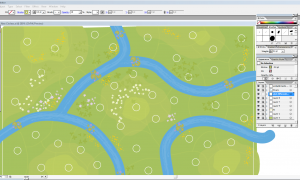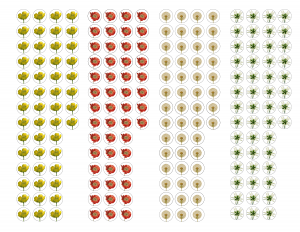Play the original game and analyze it
What are its core mechanics?
Risk is a strategy board game of diplomacy, conflict and conquest for two to six players.
The goal of the game is to occupy every territory on the board and in doing so, eliminate the other players.
It is turn-based, and players play in the same sequential order throughout the game.
It is also heavily based on chance (6 troops can potentially lose to 1 troop depending on the dice roll)
What makes it distinctive?
The game is fairly complex and can require some preplanning (ex. conquer an entire continent to gain bonus troops) and negotiation with other players (form allies for part of the game and yet players will also need to break this mutually beneficial relationship as the game goes on).
What are its best and worst aspects?
Best: There are many different ways the player can strategize their and there doesn’t seem to be a dominant strategy to win the game.
Worst: Players need to learn a lot of complex rules before they can start playing the game which can take a relatively long time; The game can be very lengthy (several hours); Once one player ends his/her turn, he/she basically have no meaningful interaction with the game beyond rolling defense dice.
Do some research on its history
What made it successful?
The game required a lot of tactics, strategies and negotiation skills.
You can also find enjoyment in competing with other players, especially when you can dominate them. Once you expand your initial territory, there is also the perceived glory of both war and conquest.
What was its evolution?
1957 – Original release: La Conquete du Monde (French for “The Conquest of the World”), designed by Albert Lamorisse
1959 – Parker Brothers first publishes the Risk Continental Game in the United States. It is later retitled Risk: the Game of Global Domination. The rules are slightly modified.
1986 – The game Castle Risk is published. This variation is played on a map of Europe. It included hidden armies and special cards that included commanders and spies.
1999 – A limited edition of Risk is published in France, an evolution of Castle Risk featuring historical units. An expansion in 2000 added the Ottoman Empire.
2001 – Risk players can now conquer the moon and underwater territories with Risk 2210 AD. It included sea areas and route connections. A second map board represents the moon. Playing pieces were added for five commanders for land, naval, space, nuclear, and diplomat, with five decks of commander-specific cards. Rather than total domination, victory is determined by a point system. A time limit of five turns also modifies gameplay strategy.
2002 – Risk moves to Middle-earth with the release of Lord of the Rings Risk. It has one unit leader and cards for mission, event, and power. It plays well with just two players, and is intended for two to four players.
2003 – Risk travels deeper into Middle-earth with the Lord of the Rings Trilogy Edition.
2004 – Risk: Godstorm is published, injecting mythology into the game of world domination.
2005 – Risk: Star Wars – The Clone Wars Edition is published in concert with the release of the third Star Wars prequel, Revenge of the Sith.
2006 – Risk: Star Wars – Original Trilogy Edition is published. The game features three factions, each with its own victory conditions.
2008 – A new basic edition of Risk is published by Hasbro. Risk 1959 is a reproduction of the original game from 1959.
Source: https://www.thespruce.com/history-of-risk-412339
What are some similar games?
Small World
IKUSA
Twilight Struggle
Diplomacy
Develop the prompt
Research the constraint and make it more specific.
Factors of real-world international politics that are different from Risk:
- There are around 200 nations, some of which have debatable sovereignty
- The United Nations exists and makes more decisions than war. It is led by a security council consisting of China, France, Russia, UK, USA, Bolivia, Egypt, Ethiopia, Italy, Japan, Kazakhstan, Senegal, Sweden, Ukraine, and Uruguay
- Some nations have a lot more power than others, which isn’t always proportional to size
- Air travel allows travel across non-contiguous states
- Diplomacy is more popular than war
- Imperialism is (mostly) dead (stay strong, Crimea)
- Most wars are happening in very specific locations
By targeting the fact that many people think the game Risk is too lengthy and thus becomes boring, some of our ideas try to resolve this issue by simplifying the original rules and by adapting the idea of conquest to a more modern situation. However, in some of ideas, we also try to be more extreme and make the game even more time consuming and complex.
Start prototyping
Shrink the game: What’s the minimum level of complexity you can have while still retaining its identity?
Minimum level of complexity: Players take turns picking cards of where their original armies will be. AI covers who wins with rolls etc. Smaller continental chunks. Only one type of army. 2 players.
Contemporary Board Game Mechanics:
Twitch Plays Risk: Make each decision crowdsourced. Have what would normally be a player be a team with from 5-100 players each.
Simplicity: Make Risk into only a card game. Battles could be determined by a rock paper scissors like variant.
Risk Legacy already happened.
Muster: Make Risk even more complicated and add resource management to it. Certain areas have more supplies, and so are more valuable as you can make more armies with it (example: the Middle East has more oil so you could fuel more planes). Similar to Game of Thrones Board Game.
Traitor!: All choose cards in the beginning. One Player is determined to be the traitor. While the rest of the world tries to promote world peace, save the planet, stop world hunger etc., the traitor will try to destroy the world as quickly as possible including the possibility of nukes. Bonus points for the traitor if they get the others to either not realize they are the traitor or manage to make them fight amongst themselves. Other players win by defeating traitor.
Shut Up and Play: All communication must be through 3 words or less for per ally each turn. All negotiations must be in the public. Code words are acceptable.
Non-Commodified:
Major War: First one to take over CMU campus. You have to fight for your school.
Shot Through the Heart!: To play each person must accept that war is painful. Dice rolls are flipped. 1’s are better than 2’s which are better than 6’s. When attacking, if you rolled a one, you would get one shock/punch. If you roll a six, you get six punches/shocks. This will make players have to decide whether or not it is worth it to play. If they do decide to play, then they will likely be more careful about when/where they attack. Similar to: The Painstation and Tekken Torture Tournament.





